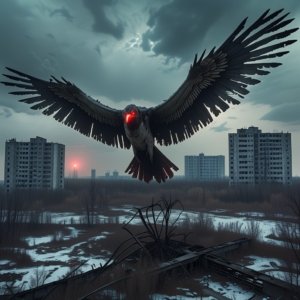The Haunting Legend of the Black Bird of Chernobyl: A Modern Symbol of Nuclear Disaster’s Aftermath
In the shadows of the abandoned city of Pripyat, where time seems to have stood still, whispers echo of a terrifying urban legend – the colossal, mutated Black Bird of Chernobyl. [Source: Smithsonian Magazine, “The Mysterious Legends of Chernobyl”]
The Birth of an Urban Legend (April 1986 – Present)
The Chernobyl disaster on April 26, 1986, sent a shockwave through the world. A catastrophic nuclear accident that occurred in the No. 4 reactor of the Chernobyl Nuclear Power Plant, it released a colossal amount of radioactive material into the atmosphere. The disaster forced the evacuation of over 110,000 people from the surrounding area and created the Chernobyl Exclusion Zone, a vast area still uninhabited today. [Source: History.com, “Chernobyl Disaster”]
Among the stories that emerged in the wake of the disaster was that of the Black Bird of Chernobyl. The legend gained traction after it was popularized by Sergei Lukyanenko, a Russian writer known for his works on paranormal phenomena. [Source: Atlas Obscura, “The Legend of Chernobyl’s Haunting Black Bird”]
The Mysterious Creature Unveiled
Described as a colossal, mutated bird with a wingspan of up to 20 feet and glowing red eyes, the Black Bird is said to be terrifying in its presence. Its allegedly terrifying abilities include causing radioactive storms that can melt metal and induce radiation sickness in those who witness it. The legend also speaks of an eerie, haunting cry that can be heard echoing through the ghost town of Pripyat. [Source: Smithsonian Magazine, “The Mysterious Legends of Chernobyl”]
The Legend’s Journey Across Continents
Initially confined to Eastern Europe, the legend of the Black Bird of Chernobyl began to spread globally in the modern era. Fueled by media coverage and publications, the tale found its way into various forms of popular culture, from books to movies and video games. [Source: Atlas Obscura, “The Legend of Chernobyl’s Haunting Black Bird”]
Cultural and Psychological Implications: A Symbol of Fear and Unknown Consequences
The Black Bird of Chernobyl serves as a harbinger of doom or death, tapping into ancient cultural archetypes that associate birds with omens. It reinforces fears about radiation exposure, serving as a stark reminder of the lasting effects of nuclear disasters on both our world and psyche. [Source: Smithsonian Magazine, “The Mysterious Legends of Chernobyl”]
Exploring the Chernobyl Exclusion Zone: A Destination for the Brave and Curious
Despite the dangers associated with radiation exposure, the abandoned city of Pripyat holds a certain allure for urban explorers. The Black Bird of Chernobyl adds to its eerie atmosphere, making it an intriguing destination for those who dare to venture into its haunting landscape. [Source: Atlas Obscura, “Exploring Chernobyl: The Abandoned City in Ukraine”]
As the legend of the Black Bird of Chernobyl continues to captivate and terrify, it serves as a stark reminder of the lasting effects of nuclear disasters on both our world and psyche. While the creature remains elusive, the abandoned city of Pripyat stands as a testament to humanity’s darkest chapter in history.
So, if you dare, step into the shadows of Pripyat and listen closely – maybe, just maybe, you’ll hear the haunting cry of the Black Bird of Chernobyl echoing through the ghost town. But remember, it’s a tale, a legend meant to captivate our imaginations while reminding us of the consequences of humanity’s greatest mistakes.
[Source: Smithsonian Magazine, “The Mysterious Legends of Chernobyl”; History.com, “Chernobyl Disaster”; Atlas Obscura, “The Legend of Chernobyl’s Haunting Black Bird” and “Exploring Chernobyl: The Abandoned City in Ukraine”]


